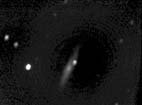 SN1998S in NGC3877, 03/24/98, jpeg, 3k
SN1998S in NGC3877, 03/24/98, jpeg, 3k
This is my first supernova 1998S which was detected on March
3, 1998. It appeared as an mag 12.5 star in NGC 3877 in UMa. The second
image of the same galaxy without the SN is from the DSS.
 SN1998S in NGC3877, 03/24/98, jpeg, 3k
SN1998S in NGC3877, 03/24/98, jpeg, 3k
Announcement of the detection:
SUPERNOVA 1998S IN NGC 3877 W.-d. Li, University of California at Berkeley, forwards a report from C. Li, Beijing Astronomical Observatory (BAO), that Zhou Wan has found an apparent supernova (unfiltered mag 15.2) on CCD images obtained with the 0.60-m BAO telescope on Mar. 3 UT as part of the BAO Supernova Survey (cf. IAUC 6612). A confirming CCD observation made with the Katzman Automatic Imaging Telescope (KAIT) of Lick Observatory by the Lick Supernova Survey (cf. IAUC 6627) indicates that the object has brightened to unfiltered mag about 13.5 on Mar. 4.3 UT. SN 1998S is located at R.A. = 11h46m06s, Decl. = +47o29'.0 (equinox 2000.0; based on the KAIT image), which is 16" west and 46" south of the nucleus of NGC 3877. As the object is embedded in the galaxy, the BAO magnitude was obtained from a subtracted image. SN 1998S is not present in images of the same field taken prior to Mar. 3. A. V. Filippenko and E. C. Moran, University of California at Berkeley, obtained a very-high-resolution (0.015 nm) echelle spectrogram of SN 1998S on Mar. 4 with the Keck-1 telescope. The probable presence of broad H-alpha emission superposed on a featureless continuum suggests that this is a type-II supernova.
The following information appeared in International Astronomical Union Circular(IUAC) 6830:
A low-resolution Keck-2 spectrum shows that the type-II SN 1998S is peculiar; the spectrum contains prominent H and He emission lines superposed on a featureless blue continuum. In many respects, the spectrum resembles that of the type-IIn...... the lines have multiple components, including a very narrow (unresolved) one that is probably produced by flash- ionized circumstellar gas. This object might become very luminous at radio and x-ray wavelengths, due to strong interaction between the ejecta and circumstellar material.......
For further information refer to Astronomical Headlines
For a detailed overview of Supernova classification see Michael Richmond's Supernova Taxonomy .
The next image was made in the night from 24th to 25th of March. It resulted from the addition of four 45 second integrations where the dark current had been removed in a first step. Telescope was my CG11 at F/6.3. Polar alignment was not well done and the problem with frost on the chip still remains, that means cooling of the CCD was also bad. The heaven at my near city location was covered with thin clouds in this night and the outside temperature was some degrees below 0 deg Celsius.
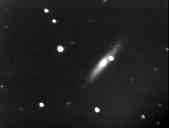 SN1998S in NGC3877, 03/25/98,jpeg, 3k
SN1998S in NGC3877, 03/25/98,jpeg, 3k
The following image was made on 26th of March, just after midnight (local time). It was composed of nineteen 35 second integrations where the dark current had been removed in a first step. Telescope was my CG11 at F/6.3. Polar alignment was a problem as in the night before and again cooling of the CCD was done with one stage only. The heaven this night was slightly better than in the night before and the outside temperature was -2 deg Celsius.
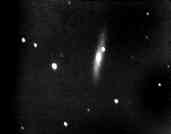 SN1998S in NGC3877, 04/01/98,jpeg, 4k
SN1998S in NGC3877, 04/01/98,jpeg, 4k
This image is from 1st of April, just after midnight (local time). 17 images were used, each individual resulted from a 70 second integration. The sky conditions were quite bad. Fog reduced the limiting magnitude of the faintest stars to mag 4 for the unaided eye and the outside temperature was quite warm (12 deg Celsius) so that cooling of the CCD was a problem.
A light curve of SN1998S can be downloaded from here . Another source for a light curve of SN1998S can be found here .
Some data about NGC 3877:
Magnitude:11.9 RA:11h 46m 8.0s Dec:+47d 29' 39" Epoch 2000 Size (mins) 5.5 x 1.3 Constellation Ursa Major Description in Deep Sky Field Guide to Uranometria 2000:Bright middle, no bright nucleus but star superimposed very near, two main knotty arms de Vaucouleurs classification:SA(s)c:II-III In English:Spiral, S-shaped (uncertain) luminosity class II-III .
The best images I have found so far is this CfA SN image Or this one, made with the 1.2-meter reflector at the Fred Lawrence Whipple Observatory outside Tucson, Arizona.
This next image was made in the night from 18th to 19th of May. Thirteen images were combined. For details see SN1998aq from the same night. The Supernova has recognizable faded if you compare it to the previous images from March. The image is zoomed two times. Severe degradation of contrast is caused by dew on the Schmidt corrector plate of my telescope.
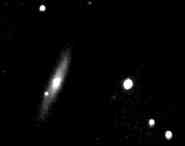 SN1998s
in NGC 3877, 05/18/98,jpeg, 6k
SN1998s
in NGC 3877, 05/18/98,jpeg, 6k
Wow, what a night, 3 Supernovae and one Sky-beamer in one night. The first SN1998bu can be found below, the next SN1998S follows here, the third, SN1998aq again below.
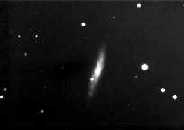 SN1998s
in NGC 3877, 05/19/98,jpeg, 6k
SN1998s
in NGC 3877, 05/19/98,jpeg, 6k
The above image was made in the night from 19th to 20th of May. 22 images were combined in the usual way. The Supernova has recognizable faded if you compare it to the previous images from March. The image is zoomed two times.
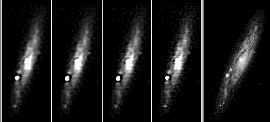 SN1998s
compared with La Palma image ,jpeg, 13k
SN1998s
compared with La Palma image ,jpeg, 13k
I use this image to make some computational efforts to bring out more details, e.g. cloud structure, in the galaxies outer portions. The results should be compared with the rightmost image, which was made with the 2.5meter Nordic Optical Telescope, La Palma. It is obvious, that much more detail is hidden in the original image, than one would expect in the first moment.
A lightcurve at this Page
This is my third Supernova. Here is the original announcement form IAU-Circular06876.html:
SUPERNOVA 1998aq IN NGC 3982 Magnitude obtained by D. Hanzl, Brno, Czech Republic (0.4-m reflector + CCD + V filter; GSC comparison stars):Apr. 14.834 UT, 14.3.
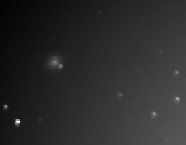 SN1998aq
in NGC 3982, 05/18/98,jpeg, 6k
SN1998aq
in NGC 3982, 05/18/98,jpeg, 6k
The above image was made in the night from 18th to 19th of May. It resulted from the addition of 18 70 second integrations where the dark current had been removed in a first step. The image is zoomed by 2. Telescope was my CG11 at F/6.3. Polar alignment was done with the help of my new polar axis finder and the problem with frost on the chip is solved now. The heaven at my location was hazy this night and the outside temperature was 9 degrees Celsius.
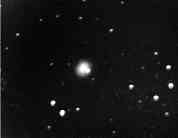 SN1998aq
in NGC 3982, 05/19/98,jpeg, 6k
SN1998aq
in NGC 3982, 05/19/98,jpeg, 6k
Better conditions in this night, 19th to 20th of May. Improved cooling of the CCD, 22 images, zoomed by 2.
More details and finder charts on David Bishops homepage, see below.
A lightcurve can be found here .
Here follows my second Supernova. The original announcement form IAU-Circular06899.html:
SUPERNOVA 1998bu IN NGC 3368 Mirko Villi, Forli, Italy, reports his discovery on CCD images taken on May 9.9 UT of an apparent supernova (mag about 13) located about 60" north of the center of NGC 3368 = M96. Villi notes that a previous CCD image taken on Apr. 21.9 shows no object in this position, neither is anything visible on several atlases of galaxy images. S. Nakano, Sumoto, Japan, reports that M. Aoki (Toyama) has obtained a CCD image of SN 1998bu (V = 11.8) on May 10.618 with a 0.43-m reflector in bad weather conditions, from which the following precise position was measured:R.A. = 10h46m46s.03, Decl. = +11o50'07".1 (equinox 2000.0), which is 4".3 east and 55".3 north of the center of NGC 3368. No star was visible on previous frames of this galaxy taken by Aoki. B. A. Skiff, Lowell Observatory, reports that he viewed the apparent supernova on May 10.33 UT at visual mag perhaps 12.0-12.5. D. Hanzl, Brno, Czech Republic, reports that he imaged SN 1998bu on May 10.835 at V = 12.37 with a 0.40-m reflector + CCD; he gave the offset as 49" north of the galaxy's center.
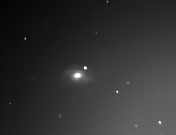 SN1998bu in M96, 05/15/98,jpeg, 6k
SN1998bu in M96, 05/15/98,jpeg, 6k
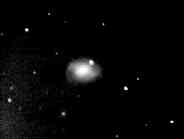 SN1998bu in M96, 05/19/98,jpeg, 6k
SN1998bu in M96, 05/19/98,jpeg, 6k
A lightcurve can be found here .
Finder charts and more on this SN-Page of David Bishop
A very good page about Ok, this is not a supernova but it is interesting
although.
IAU circular No. 6981 announced that the Katzman Automatic Imaging Telescope
(KAIT) team has discovered an apparent nova in M31. This nova is unusually
bright and it would seem to have reached magnitude 14.4 on 1998 July 27.
An image by Nick James was taken on 1998 July 29 when the nova was around
magnitude 15.8.
It can be downloaded from here
The discovery image from Lick Observatory is here
I have tried to find this nova in the night from August 14 to 15. The
result was processed to a comparable degree and it is shown below. No star
could be detected at the indicated position of the above image. :-((
Below you can see Supernova SN1998dh, No.4
in my personal statistics. Here is the original announcement form IAU-Circular06978.html:
SUPERNOVA 1998dh IN NGC 7541 W. D. Li, M. Modjaz, E. Halderson, T.
Shefler, J. Y. King, R. R. Treffers, and A. V. Filippenko, University of
California at Berkeley, report their discovery of an apparent supernova
during the course of the Lick Observatory Supernova Search (cf. IAUC 6627)
with the 0.8-m Katzman Automatic Imaging Telescope (KAIT). SN 1998dh was
found and confirmed in unfiltered CCD images obtained on July 20.5 (mag
about 16.8) and 24.5 UT (mag about 15.3). The new object is located at
R.A. = 23h14m40s.31, Decl. = +4 32'14".1 (equinox 2000.0), which is about
53".5 west and 10".4 north of the nucleus of NGC 7541. A KAIT image obtained
on July 16.5 did not show a star at the position of SN 1998dh (limiting
mag about 19.0).
The above image was made in the night from 17th to 18th of August.
It resulted from the addition of 18 60 second integrations where
the dark current had been removed in a first step. The image is zoomed
by 2. Telescope was my CG11 at F/6.3. The SN is of type Ia and meanwhile
it has reached mag 13.9.
This is the result of a hard work. My first
extra-galactic nova ! Very faint, at the limit of visibility.
The image shows M32, the close companion of the great Andromeda Galaxy.
The nova can be found at the indicated position. It was detected on August
29, by the Lick Observatory Supernova Search Team. On the discovery
image the Nova was much brighter.
My image was made under dramatic conditions. Exceptionally the
sky cleared for less than an hour. I hurried to set up my telescope, attached
the camera, waited for the CCD to cool down and when all was done, new
clouds covered the sky. I knew, in this summer it will take many days or
weeks until a next chance would come, almost certainly to late for this
elusive target. But I had good luck. Because it was quite windy the heaven
opend again, long enough to make 5 integrations of 45 seconds each. Not
much, but enough to confirm the nova with the above image.
I did not expect it 3 days ago ! This is my
second extra-galactic nova ! and the second
Discovery reported in IAU-Circular 7015:
NOVA IN M31
Although the night was wet, cold and thin clouds covered the sky, I
was able to make this image of the second nova in M31, which appeard in
the course of a month. I think that is a great result for an amateur,
operating his mobile "observatory" roughly 1km from the center of a city.
The image is highly processed and you must adjust brightness and contrast
of your monitor to see the nova at the indicated position. If you compare
my image to the discovery
image , the nova was mag 17.8 at that time, you can see, that novae
fade very quickly. My result was obtained from 38 integrations of 45 seconds.
The processing history is to long to be reported here but it caused the
big central artefact and the black cores in the stars. You can also see,
that the spiral structure of the great Andromeda Galaxy reaches till to
the very center.
Here comes Supernova 1998eb. The fifth
and the faintest for me so far (mag 17.8). Below the announcement from
IAU-Circular 7016:
SUPERNOVA 1998eb IN NGC 1961
W. D. Li, M. Modjaz, E. Halderson, T. Shefler,
J. Y. King, M. Papenkova, R. R. Treffers, and A. V. Filippenko, University
of California at Berkeley, report their discovery of an apparent supernova
in NGC 1961 during the course of the Lick Observatory Supernova Search
(cf. IAUC 6627) with the 0.8-m Katzman Automatic Imaging Telescope (KAIT).
SN 1998eb was found and confirmed on unfiltered images taken on Sept. 17.5
and 19.4 UT (unfiltered magnitude about 17.8), respectively. The
object, is located at R.A. = 5h42m12s.02, Decl. = +69o22'26".3 (equinox
2000.0), which is about 38".8 east and 17".0 south of the nucleus of NGC
1961. A KAIT image of NGC 1961 obtained on Mar. 9.2 shows nothing
at the position of SN 1998eb (limiting mag about 18.5).
The image is the result of 34 single integrations of 45 seconds exposure
time. Date is September 22, 23h 05m UT. Telescope was my CG11 at f/6.3,
no filters were used. The SN is of type Ia, the discovery image can be
found here.
More on this
SN-Page of David Bishop
Comments welcome, contact:
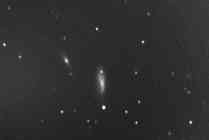 SN1998dh
in NGC 7541, 08/18/98, 2X, jpeg, 14k
SN1998dh
in NGC 7541, 08/18/98, 2X, jpeg, 14k
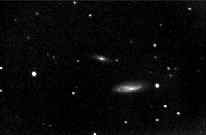 SN1998dh
in NGC 7541, 09/22/98, 2X, jpeg, 33k The above image is from September
22. The SN has clearly faded.
SN1998dh
in NGC 7541, 09/22/98, 2X, jpeg, 33k The above image is from September
22. The SN has clearly faded.
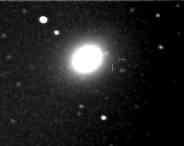 Nova
in M32, 09/12/98, 4X, jpeg, 11k
Nova
in M32, 09/12/98, 4X, jpeg, 11k
in M31 in this year !
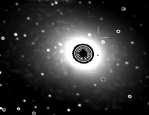 Nova
in M31,09/21/98,4X,jpeg,32k
Nova
in M31,09/21/98,4X,jpeg,32k
E. Halderson, T. Shefler, M. Modjaz, J.
Y. King, M. Papenkova, W. D. Li, R. R. Treffers, and A. V. Filippenko,
University of California at Berkeley, report their discovery of an apparent
nova in M31 (NGC 224) during the course of the Lick Observatory Supernova
Search (cf. IAUC 6627) with the 0.8-m Katzman Automatic Imaging Telescope
(KAIT). The nova was found and confirmed (unfiltered mag 17.8) on
unfiltered CCD images taken on Sept. 15.3 and 16.3 UT, respectively.
The object is located at R.A. = 0h42m46s.6, Decl. = +41o14'50" (equinox
2000.0; due to a lack of nearby stars, this semiaccurate position was calculated
as an offset from the NED position for the nucleus of M31), which is about
26" east and 78" south of the galaxy nucleus. A KAIT image of M31
taken on Aug. 31.3 showed nothing at the position of the nova (limiting
mag about 19.0).
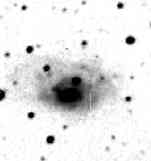 SN1998eb
in NGC 1961, 09/22/98, detail, 4X, jpeg,5k
SN1998eb
in NGC 1961, 09/22/98, detail, 4X, jpeg,5k
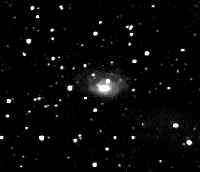 SN1998eb
in NGC 1961, 09/22/98, 2X, jpeg,14k
SN1998eb
in NGC 1961, 09/22/98, 2X, jpeg,14k